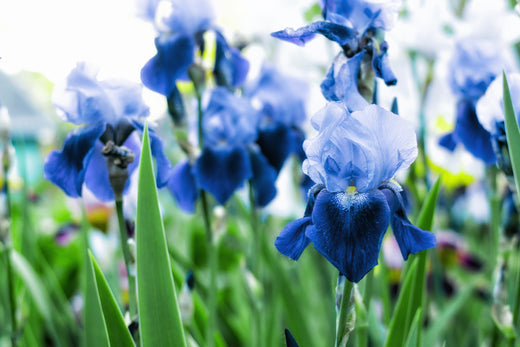Bearded Iris (Iris germanica) is a breathtakingly beautiful and exceedingly popular perennial, renowned for its captivating charm, striking flowers, and enchanting foliage. This regal member of the Iris family boasts an illustrious history, earning its name from the delicate "beard" of hairs adorning the centre of its splendid blooms. Revered for its diverse and vivid colour palette, the Bearded Iris enthrals garden enthusiasts with an extensive array of hues, ranging from rich velvety purples and radiant blues to delicate pastels and vibrant yellows. The exuberant ruffles and falls that form each flower create a mesmerising display, attracting pollinators such as bees and butterflies to its alluring nectar-rich blooms.
How to successfully plant Bearded Iris in your gardenSelect an Ideal Location:
Bearded Iris thrives in a full sun location, so choose a spot that receives at least 6 hours of sunlight per day. The soil should be well-draining to prevent waterlogging, as standing water can cause rhizome rot.
Prepare the Soil:Bearded Iris prefers neutral to slightly alkaline soil with a pH range of 6.8 to 7.5. Test your soil's pH and amend it if necessary using lime to raise pH or sulphur to lower pH. Ensure the soil is loose and friable by adding compost or well-rotted organic matter.
Planting Time:The best time to plant Bearded Iris is in late summer or early autumn. This allows the rhizomes to establish their root system before winter dormancy and ensures a strong start for the spring growing season.
Planting Process:
1. Trim the rhizomes: When you receive the rhizomes, trim the leaves back to about 15 centimetres in length and cut any damaged or dead roots.
2. Dig the hole: Prepare a shallow hole about 25-30 centimetres wide and 10-15 centimetres deep.
3. Place the rhizomes: Position the trimmed Bearded Iris rhizome in the hole with the top slightly above the soil level and the roots spread down the sides of the mound.
4. Backfill: Gently backfill the hole with soil, ensuring the rhizome is firmly anchored in the ground.
5. Watering: Water the newly planted rhizomes thoroughly to help settle the soil and promote root establishment.
Keep the soil evenly moist after planting, but avoid overwatering, as Bearded Iris prefers slightly drier conditions during its dormant period in winter.
Mulching:
Apply a thin layer of mulch around the base of the plant to conserve moisture and suppress weed growth. Avoid burying the rhizome under heavy mulch, as this can lead to rot.
Fertilisation:Bearded Iris doesn't require heavy fertilisation. Apply a balanced fertiliser, low in nitrogen, in early spring when new growth emerges to provide essential nutrients.
Maintenance:
- Remove weeds around the Bearded Iris to prevent competition for nutrients and water.
- Deadhead the flowers after they bloom to encourage continuous flowering and prevent seed formation.
- Divide crowded clumps every 3 to 4 years to maintain plant health and improve blooming.
Bearded Iris is generally hardy and can withstand cold winter temperatures. No special winter care is necessary, but ensure the soil remains well-draining to avoid waterlogged conditions.
Pests and Diseases:
Bearded Iris is relatively resistant to pests and diseases. However, keep an eye out for aphids, iris borers, and fungal issues. Proper sanitation and good air circulation can help prevent problems.
Quick Guide:
1. Select a sunny location with well-draining soil.2. Prepare the soil with compost and adjust pH if needed.
3. Plant Bearded Iris rhizomes in late summer or early autumn.
4. Backfill the hole with soil, keeping the top of the rhizome slightly above the soil level.
5. Water thoroughly after planting, then keep the soil evenly moist.
6. Apply a thin layer of mulch and fertilise with a balanced, low-nitrogen fertiliser in spring.
7. Remove weeds and deadhead flowers for better blooming.
8. Divide crowded clumps every 3 to 4 years.
9. Provide good winter drainage and monitor for pests and diseases.
Follow these guidelines to successfully plant and grow Bearded Iris in your garden, enjoying their vibrant blooms and beauty year after year. With its robust and resilient nature, the Bearded Iris effortlessly thrives in various growing conditions. Gardening aficionados and horticulturists alike find solace in the Bearded Iris' versatility, as it flourishes in full sun to partial shade, delighting gardeners with an annual display of unparalleled beauty.

